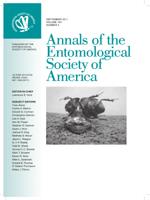Females of Phyllophaga obsoleta (Blanchard) (Coleoptera: Scarabaeoidea: Melolonthidae) perform “sexual calling” with their protractile genital chamber (PGC) exposed to release substances that attract males. Histological aspects of the PGC and accessory glands (AGs) of P. obsoleta females were studied. Studies with light microscope and transmission electron microscope revealed exocrine tissue in the posterior section of the PGC, where it might be producing the attractants. This epithelial gland is formed by a basement membrane, a hypodermis for substance production, secretion, and transport (cells, nucleus, mitochondria, endoplasmic reticulum, Golgi complex, and presence of folds in the plasma membrane), as well as evidence of the substance to be secreted to the outside (connecting cuticular pores to plasma membrane). Histological similarities between AG types I and II were observed, although only the PGC had properties of class I cells. These results suggest that the posterior section of the P. obsoleta PGC is involved in sex pheromone production.
How to translate text using browser tools
1 September 2011
Tissues Involved in Sex Pheromone Production in Phyllophaga obsoleta (Coleoptera: Scarabaeoidea: Melolonthidae)
Angel A. Romero-López,
René Arzuffi,
Jorge Valdez,
Esther Sánchez-Espíndola,
Miguel A. Morón
ACCESS THE FULL ARTICLE
It is not available for individual sale.
This article is only available to subscribers.
It is not available for individual sale.
It is not available for individual sale.
Histology
Phyllophaga obsoleta
protractile genital chamber
sex pheromone





